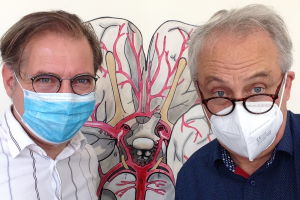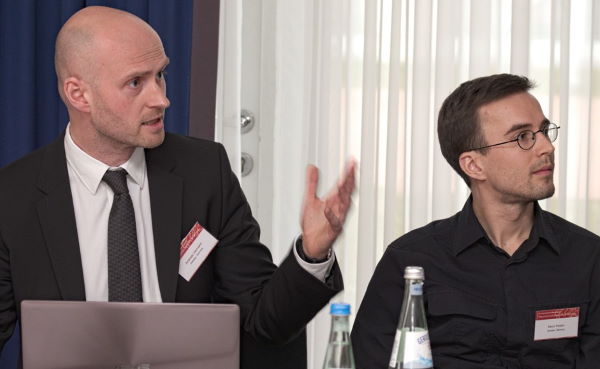 Adrian Danek and Gabriel Miltenberger-Miltenyi in Munich have successfully re-established the chorein blot diagnosis and offer it again for patients world-wide. The diagnosis is carried out using two different chorein antibodies in parallel, binding to the start (N-terminus) and the end (C-terminus) of the protein, respectively. Analysis with each antibody is run in duplicate. Thus, the diagnosis is more accurate.
Adrian Danek and Gabriel Miltenberger-Miltenyi in Munich have successfully re-established the chorein blot diagnosis and offer it again for patients world-wide. The diagnosis is carried out using two different chorein antibodies in parallel, binding to the start (N-terminus) and the end (C-terminus) of the protein, respectively. Analysis with each antibody is run in duplicate. Thus, the diagnosis is more accurate.
The diagnostic service continues to be offered for free, through the generous donation of seed money by Betty and Carl Pforzheimer to the Advocacy, in honour and in memory of Glenn Irvine.
Based on the revitalized Western blot service, Gabriel Miltenberger-Miltenyi was able to contribute to a recent paper from Sweden that describes a number of newly diagnosed patients affected by ChAc (Niemelä V, et al. Neurol Genet. 2020 Apr 27;6(3):e426).
Besides, the Munich team provides support for the genetic characterization of ChAc patients and is continuously available for clarification of questions related to chorein and genetic diagnosis (danek@lmu.de and gmiltenyi@medicina.ulisboa.pt). Together with Antonio Velayos-Baeza, they became curators for the VPS13A gene at the open-access Leiden Open Variation Database (https://databases.lovd.nl/shared/genes/VPS13A).
In the first analysis of 22 patients with ChAc-suggestive clinical diagnosis, yet normal chorein band in Western blot, they managed to detect pathogenic mutations in five patients. Of these, in four patients a core neuroacanthocytosis syndrome was diagnosed: in two patients each, mutations in the VPS13A gene (confirming the diagnosis of ChAc) and in the XK gene (associated with McLeod syndrome), respectively. One patient was found to harbour a mutation in another movement disorder associated gene (KMT2B).
In addition, the Munich team continues with the elaboration of a zebrafish model for neuroacanthocytosis diseases (both ChAc and MLS) in collaboration with local colleagues at the German Center for Neurodegenerative Diseases (DZNE).
PHOTO CREDIT: Adrian Danek and Gabriel Miltenberger-Miltenyi in Munich
_____
Ruth Walker in New York has reported an article about McLeod’s patients which may be of interest. In the Parkinsonism and Related Disorders Journal 2019 Jul;64:293-299.doi: 10.1016/j.parkreldis.2019.04.022. Epub 2019 May 2.
McLeod syndrome: Five new pedigrees with novel mutation
https://pubmed.ncbi.nlm.nih.gov/31103486/
Thank you Ruth and your colleagues.
_____
Rostock group reveals increase of neurodegeneration marker in the blood of neuroacanthocytosis patients
German researchers from the Translational Neurodegeneration Section “Albrecht Kossel” at the University of Rostock revealed in an exploratory study that a marker of neurodegeneration is increased in the blood of patients suffering from chorea-acanthocytosis (ChAc) and McLeod syndrome (MLS).
The marker, called neurofilament, is a neuronal protein which is known to be increased in the cerebrospinal fluid and/or blood in a number of neurological diseases, such as Alzheimer’s disease, Multiple Sclerosis, ALS or Huntington’s disease. Testing for neurofilament levels already contributes to diagnosis and performance of clinical trials in these conditions.
The researchers therefore analyzed for the first time neurofilament levels in the serum of several neuroacanthocytosis patients and compared it to healthy control subjects. They found - compared to the diseases stated above - a moderate increase of this marker in all patients. This most probably reflects chronic damage of neuronal cells both in the brain as well as in the peripheral nerves due to the neurodegenerative process causing the symptoms of ChAc and MLS.
The initiators of the study, Andreas Hermann and Kevin Peikert, hope that their findings will contribute to enable future clinical trials in the neuroacanthocytosis field. In a next step, however, the results first need to be confirmed and further evaluated in a larger cohort of neuroacanthocytosis patients. Kevin Peikert, the first author of the study, stated that one main open question concerned the usability of serum neurofilament as biomarker for disease progression as it seemed to stay rather stable within the observation period of the study.
The authors thank the patients and their families for contributing to this study and the Advocacy for Neuroacanthocytosis Patients for the support throughout the last years.
The study will be published in Parkinsonism and Related Disorders. https://doi.org/10.1016/j.parkreldis.2020.09.004
Peikert K, Akgün K, Beste C, Ziemssen T, Buhmann C, Danek A, Hermann A. Neurofilament light chain in serum is significantly increased in chorea-acanthocytosis. Park Relat Dis. 2020. In press.

PHOTO CREDIT: Prof. Andreas Hermann, MD, PhD / Dr. Kevin Peikert, MD © Arun Pal
For correspondence, please contact:
Prof. Andreas Hermann, MD, PhD / Dr. Kevin Peikert, MD
Translational Neurodegeneration Section "Albrecht Kossel"
Department of Neurology
University Medical Center Rostock
Gehlsheimer Straße 20, 18147 Rostock, Germany
Phone: +49 (0)381 494-9511
e-Mail: Andreas.Hermann@med.uni-rostock.de
website : https://albrecht-kossel-institut.med.uni-rostock.de/